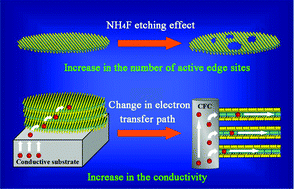A strategy to synergistically increase the number of active edge sites and the conductivity of MoS2 nanosheets for hydrogen evolution†
Abstract
Nanostructured MoS2 is very promising as an electrocatalyst for hydrogen evolution due to a greater number of active edge sites. However, a very large resistance between basal planes decreases the overall efficiency of hydrogen evolution, and greatly limits its application in industry. Herein we develop a facile strategy to synergistically increase the number of active edge sites and the conductivity of MoS2. MoS2 nanosheet arrays can be grown vertically on a carbon fiber cloth (CFC) substrates by a facile strategy. On the one hand, ammonium fluoride in the reaction system could effectively etch the inert basal plane of the MoS2 nanosheets, leading to the formation of pits in the inert basal plane of the MoS2 nanosheets. Thereby the number of active edge sites is significantly increased. On the other hand, the vertical growth of MoS2 nanosheet arrays on CFCs can significantly decrease the resistance of MoS2-based electrocatalysts. As a result, the MoS2-based electrocatalysts exhibit excellent catalytic activity for hydrogen evolution reactions, with a small Tafel slope and a large cathodic current density. Moreover, the CFC can be repeatedly utilized as a template to grow ultrathin MoS2 nanosheet arrays for HERs. The excellent activity and recyclable utilization, as well as mass production, indicate that the composite has promising applications in industry.


 Please wait while we load your content...
Please wait while we load your content...